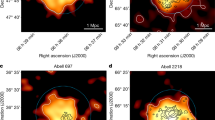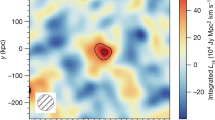Abstract
Some galaxies are very luminous in the radio part of the spectrum. These ‘radio galaxies’ have extensive (hundreds of kiloparsecs) lobes of emission powered by plasma jets originating at a central black hole1. Some radio galaxies can be seen at very high redshifts2, where in principle they can serve as probes of the early evolution of the Universe. Here we show that, for any model of radio-galaxy evolution in which the luminosity decreases with time after an initial rapid increase (that is, essentially all reasonable models3), all observable high-redshift radio galaxies must be seen when the lobes are less than 107 years old. This means that high-redshift radio galaxies can be used as a high-time-resolution probe of evolution in the early Universe. Moreover, this result explains many observed trends of radio-galaxy properties with redshift4,5,6,7,8,9, without needing to invoke explanations based on cosmology10 or strong evolution of the surrounding intergalactic medium with cosmic time6, thereby avoiding conflict with current theories of structure formation11.
This is a preview of subscription content, access via your institution
Access options
Subscribe to this journal
Receive 51 print issues and online access
$199.00 per year
only $3.90 per issue
Buy this article
- Purchase on Springer Link
- Instant access to full article PDF
Prices may be subject to local taxes which are calculated during checkout

Similar content being viewed by others
References
Begelman, M. C., Blandford, R. D. & Rees, M. J. Theory of extragalactic radio sources. Rev. Mod. Phys. 56, 255–351 (1984).
Rawlings, S.et al. Aradio galaxy at redshift 4.41. Nature 383, 502–505 (1996).
Baldwin, J. E. in Extragalactic Radio Sources 21–24 (Proc. 97 IAU Symp., Reidel, Dordrecht, (1982).
McCarthy, P. J., van Breugel, W., Spinrad, H. & Djorgovski, S. Acorrelation between the radio and optical morphologies of distant 3CR radio galaxies. Astrophys. J. 321, L29– L33 (1987).
Kapahi, V. K., Subrahmanya, C. R. Kulkarni, V. K. On the interpretation of the observed angular-size-flux-density relation for extra-galactic radio sources. J. Astrophys. Astron. 8, 33–50 (1987 ).
Barthel, P. D. & Miley, G. K. Evolution of radio structure in quasars: a new probe of protogalaxies? Nature 333, 319–325 (1988).
Blundell, K. M., Rawlings, S. & Willott, C. J. The nature and evolution of classical double radio sources from complete samples. Astron. J. 117, 677–706 (1999).
Garrington, S. T. & Conway, R. G. The interpretation of asymmetric depolarization in extragalactic radio sources. Mon. Not. R. Astron. Soc. 250, 198–208 (1991).
Hughes, D. H., Dunlop, J. S., Archibald, E. N., Rawlings, S. & Eales, S. A. Cosmological evolution of the submillimetre luminosity of high-redshift radio galaxies.In The Birth of Galaxies (ed. Guiderdoni, B.) (Frontieres, Paris, in the press).
Daly, R. A. Cosmology with powerful extended radio sources. Astrophys. J. 426, 38–50 (1994).
Eke, V. R., Cole, S. & Frenk, C. S. Cluster evolution as a diagnostic for Ω. Mon. Not. R. Astron. Soc. 282, 263– 280 (1996).
Reynolds, C. S. & Fabian, A. C. ROSAT PSPC observations of Cygnus A: X-ray spectra of the cooling flow and hotspots. Mon. Not. R. Astron. Soc. 278, 479–487 (1996).
Neumann, D. M. 3C 295, a cluster and its cooling flow at z = 0.46. Astrophys. J. 520 (in the press); preprint astro-ph/9902035 at 〈 http://xxx.lanl.gov〉 (1999).
Navarro, J. F., Frenk, C. S. & White, S. D. M. Auniversal density profile from hierarchical clustering. Astrophys. J. 490, 493– 508 (1997).
Crawford, C. S. & Fabian, A. C. ROSAT observations of distant 3CR radio galaxies—II. Mon. Not. R. Astron. Soc. 282, 1483–1488 ( 1996).
Bower, R. G. & Smail, I. Aweak lensing survey in the fields of z ∼ 1 luminous radio sources. Mon. Not. R. Astron. Soc. 290, 292–302 ( 1997).
Deltorn, J. M., Le Fevre, O., Crampton, D. & Dickinson, M. Amassive cluster of galaxies at z = 0.996. Astrophys. J. 483, L21–L24 ( 1997).
Hill, G. J. & Lilly, S. J. Achange in the cluster environments of radio galaxies with cosmic epoch. Astrophys. J. 367, 1–18 (1991).
Falle, S. A. E. G. Self-similar jets. Mon. Not. R. Astron. Soc. 250, 581–596 (1991).
Kaiser, C. R., Dennett-Thorpe, J. & Alexander, P. Evolutionary tracks of FRII sources through the P–D diagram. Mon. Not. R. Astron. Soc. 292, 723–732 (1997).
Riley, J. M. Bright sources selected at 151 MHz—I. Some observations and identifications. Mon. Not. R. Astron. Soc. 238, 1055– 1075 (1989).
Sanders, D. B.et al . Ultraluminous infrared galaxies and the origin of quasars. Astrophys. J. 325, 74– 91 (1988).
De Young, D. S. The ‘alignment effect’ and the evolution of dust in high-redshift radio galaxie. Astrophys. J. 507, 161– 172 (1998).
Best, P. N., Longair, M. S. & Röttgering, H. J. A. Evolution of the aligned structures in z ∼ 1 radio galaxies. Mon. Not. R. Astron. 280, L9–L12 (1996).
Genzel, R., Lutz, D. & Tacconi, L. Star formation triggered by galaxy collisions. Nature 395, 859–862 ( 1998).
Longair, M. S. On the interpretation of radio source counts. Mon. Not. R. Astron. Soc. 133, 421–436 ( 1966).
Aarseth, S. J. & Fall, S. M. Cosmological N -body simulations of galaxy merging. Astrophys. J. 236, 43–57 (1980).
Ellingson, E., Green, R. F. & Yee, H. K. C. Clusters of galaxies associated with quasars II: galaxy cluster dynamics. Astrophys. J. 378, 476–486 (1991).
Prestage, R. M. & Peacock, J. A. The cluster environments of powerful radio galaxies. Mon. Not. R. Astron. Soc. 230, 131–160 ( 1988).
Owen, F. N., Ledlow, M. J., Morrison, G. E. & Hill, J. M. The Cluster of galaxies surrounding Cygnus A. Astrophys. J. 488, L15–L18 (1997).
Markevitch, M., Sarazin, C. L. & Vikhlinin, A. Physics of merging clusters Cygnus A, A3667 and A2065. Astrophys. J. 521 (in the press); preprint astro-ph/9812005 at 〈http://xxx.lanl.gov〉 (1998).
Laing, R. A., Riley, J. M. & Longair, M. S. Bright radio sources at 178 MHz: flux densities, optical identifications and the cosmological evolution of powerful radio galaxies. Mon. Not. R. Astron. Soc. 204, 151– 187 (1983).
Acknowledgements
K.M.B. thanks the Royal Commission for the Exhibition of 1851 for a research fellowship.
Author information
Authors and Affiliations
Corresponding author
Rights and permissions
About this article
Cite this article
Blundell, K., Rawlings, S. The inevitable youthfulness of known high-redshift radio galaxies. Nature 399, 330–332 (1999). https://doi.org/10.1038/20612
Received:
Accepted:
Issue Date:
DOI: https://doi.org/10.1038/20612
This article is cited by
-
Distant radio galaxies and their environments
The Astronomy and Astrophysics Review (2008)
Comments
By submitting a comment you agree to abide by our Terms and Community Guidelines. If you find something abusive or that does not comply with our terms or guidelines please flag it as inappropriate.




